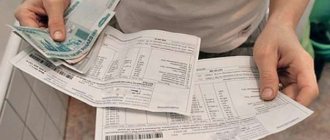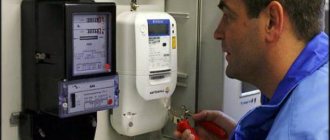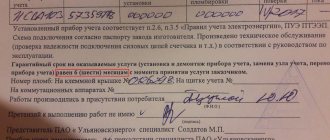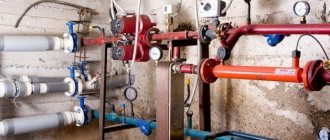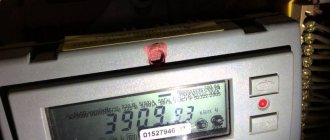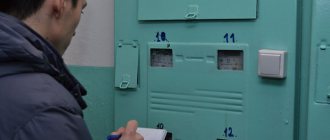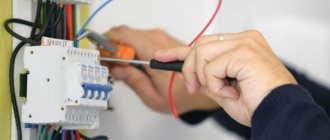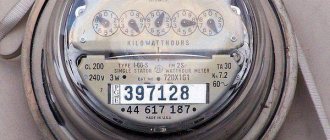What is a three-phase electric meter?
What does a 3 phase electric meter look like?
A three-phase electric meter is a standard metering device installed in individual residential premises or in their complexes.
The main function of this device is to count the electricity consumed in a particular home and reflect the generated readings in a form convenient for humans.
The difference between a 3-phase meter and a single-phase one is that the first one is able to work in more congested networks, is less demanding in use and more accurate in readings.
However, for small residential premises there is no particular point in installing three-phase metering devices, since a single-phase device can fully display all the necessary readings. In any case, both types of electricity meters are used with equal frequency in our country.
It is very simple to distinguish between a three-phase and a single-phase meter - just pay attention to how many wires fit to the device:
- if 3 or less, the device operates on one phase;
- if more than 3, the device is three-phase.
Today, two types of three-phase electric meters are produced: induction and electric.
The first ones work on the principle of displaying power consumption readings on special scrolling elements. And the latter display data on an electronic display.
Induction counter device
An induction meter consists of two main electromagnets, they are located at an acute angle of 90 degrees opposite each other. There is an aluminum disk in a magnetic field, and it is this that shows us the energy consumption.
To include the meter in the circuit, it is necessary to connect its current winding to all electrical receivers in series. The voltage winding is connected in parallel. During the passage of electric current through the windings of an induction meter, alternating magnetic fluxes arise in the cores, they penetrate the aluminum disk and induce so-called eddy currents in it. It will be interesting to know which meter is better to install in the house.
Eddy currents interact with magnetic fluxes and create forces, with the help of which the disk begins to spin. The disk is directly connected to a standard counting mechanism. Depending on the disk rotation speed, the consumed electrical energy is taken into account.
The following is the diagram of an electric meter.
Let's do a little decoding:
- Current windings.
- Voltage windings.
- Worm mechanism.
- Counting mechanism.
- Aluminum disc.
- A magnet that slows down the disk.
We have already looked at the diagram above, now look at what an electric meter looks like in cross-section (live).
If the electricity consumed is large, then three-phase induction meters are used, their operating principle is similar to single-phase ones. Watch the video to see how an electric meter works.
Where is the meter installed and what models are most popular?
Tips for installing and choosing a three-phase meter
As noted earlier, to calculate electricity consumption in a small area (apartment, private house, etc.) there is no particular advisability in using 3-phase meters.
However, according to the latest statistics, about a third of private homes in the Russian Federation are equipped with just such an electricity meter.
As for the wider range of uses of three-phase devices, their use is common in:
- Apartment buildings (when it comes to calculating electricity throughout the house).
- Large technical enterprises.
- Large offices.
That is, 3-phase meters are used mainly where the electrical network extends over a large area and the load on it is quite high. At the moment, the most popular models of such devices are as follows:
- Among the induction options are Mercury 200, Izmeron and Energomer.
- Among the electronic versions of the devices are Mercury 200, Energomer, Micron and Saiman.
There are no particular differences between electric meters from different manufacturers, so we probably won’t consider each of them in more detail.
Calculating readings without a meter
In the absence of an individual device, the average electricity consumption for the region is used. The cost is not calculated based on the area of the room, and the relationship is established based on the type of slab in the house. How to calculate the amount of electricity used if there is no meter is given in the following example.
– number of people living in the apartment - h = 3;
– average consumption depending on the type of slab - n = 111 kW/h;
– local cost of electricity - t = 3.5 rubles. per kW/h.
The general calculation formula is: C = (h*p)*t.
We substitute the values: C = (3*111)*3.5 = 1165.5 rubles.
Three-phase meter - how to take readings?
What numbers should be sent to electricity meters?
Readings from any electric meter are taken by the owners of the facility in which the device is installed, or by authorized persons from the management company that provides utility services to a specific group of people.
At the same time, the owner of the property has every right not to allow his meter readings to be taken either by representatives of the management company or by other persons.
In this case, the cost of electricity provision services will be calculated at average regional tariffs.
The actual procedure for taking readings is different for different types of three-phase meters:
- When using a device with an inductive counting form, in order to obtain the required numbers, it is necessary to copy the available readings on the rotating display of the device onto a piece of paper. If one or two digits, usually out of five or six in general, have a different color than the rest, then when readings are taken, these numbers are discarded (they show an intermediate calculation of electricity consumption on a small scale, so they are not taken into account when determining monthly readings).
- When using an electronic meter, you will have to refer to its instructions. The fact is that different models of meters show 10-15 seconds: time, date, power consumption indicators for all time and by periods (T1 - 7-23:00, T2 - 23-7:00, T3, T4, etc.). d. – grace periods). As a rule, the sequence of displaying values corresponds to that described above, however, for the most accurate determination, you should refer to the previously mentioned counter instructions.
How to calculate electricity using a meter? Taking readings from the 3rd meter is only half the battle. Next you will have to do the following:
- Determine how much electricity was consumed over the last month. To do this, it is enough to take the meter readings for the previous month and subtract them from the currently available ones. You can find out these readings by monthly recording, or look at the last paid receipt for electricity.
- Multiply the resulting electricity figure by the current tariff in your region. So, for example, with an electricity consumption of 200 kW per month and a tariff of 4 rubles per 1 kW, you will have to pay 200 * 4 = 800 rubles.
How to read data from a multi-tariff electricity meter
Multi-tariff meters "Pulsar" are an effective solution for saving energy if its consumption is paid at several tariffs. They allow you to keep track of energy at four tariffs in twelve seasons. Let's look at how to read a multi-tariff electricity meter and determine consumption.
Each tariff is indicated on the meter with a separate marking - T1, T2, T3, T4. We rewrite the readings for each marking. For example:
- T1 - 2022 kW;
- T2 - 1813 kW;
- T3 - 1310 kW;
- T4 - 1045 kW.
Next, we look at the readings for all tariffs for the previous reporting period (can be found in the device memory). For example:
- T1 - 1862 kW;
- T2 - 1712 kW;
- T3 - 1205 kW;
- T4 - 1000 kW.
The data is shown automatically. You must wait until information on a specific tariff appears on the screen.
The next step is to calculate the electricity consumption for each tariff:
- 2022 – 1862 = 160 kW;
- 1813 – 1712 = 101 kW;
- 1310 – 1205 = 105 kW;
- 1045 – 1000 = 45 kW.
This data is entered into the receipt.
Types and rules for choosing an electric current converter
Transformer equipment that reduces current (CT) is classified according to various characteristics, including conversion ratio. This equipment is required if the facility consumes power that is several times greater than the capabilities of a conventional node.
The CT converts the current to a level that allows you to connect conventional one- or three-phase electricity meters for monitoring and create a line protection system.
Classification
By installation method
According to this principle, CTs are divided into:
- supporting (installed on the surface);
- pass-through (attached to the busbar);
- tire (attached to the tire);
- built into power electric current systems;
- detachable (installed on cables).
By type of insulation
An electric current transformer can be:
- with epoxy resin or special varnish;
- in a plastic case;
- with solid insulation made of porcelain, bakelite. hard plastic;
- with a viscous composition (oil);
- filled with gas;
- with oil-paper insulation.
What parameters to consider
To calculate the readings of an electric meter with current transformers, the transformation ratio is important. It can be single-stage or cascade (multi-stage). The last type of CT is distinguished by the presence of several secondary windings and a large number of turns in the primary winding.
The main condition when choosing a converter is that the electric current of the secondary winding must be the same or less than the electric current for which the electric meter is intended.
It is not advisable to buy a TT with too high a transformation level. With such a choice, you will have to install a counter at the receiving input. More popular are converters with one coefficient, which do not change the reading during operation. When using them, the problem of how the readings of an electricity meter connected through current transformers are calculated is easier to solve.
Calculation of electricity using a meter with current transformers can only be carried out if the transformation ratio is known. It must be indicated in the technical documentation with which the TT was sold and on the body. If you suspect inaccuracies in the displayed figures, you can calculate the coefficient yourself.
To calculate the ratio, you need to connect the converter to the electric current that creates a short circuit in the secondary winding and measure how many amperes there are in it.
Transformation ratio is the ratio of the values of the supplied electric current and the current passing in the secondary winding.
For example, if a short circuit is caused by 150 A, on the secondary winding 5 A, the effective coefficient is 30. This is a more accurate value than the nominal value, which is determined by the rated electric current of the primary and secondary windings. The result of calculating electric meter readings with current transformers is more accurate.
Calculation of indirect connection meter readings
CTs are installed in networks that consume hundreds of kilowatts of electrical energy. The operating principle of such a converter is based on reducing the electric current to a value that allows connecting a standard electric meter through it. For example, a 5 A meter, in a 150 A network, the CT should reduce the indicator by 30 times, that is, the transformation coefficient used in calculating the flow rate is also 30.
How to read a meter with a current transformer? You just need to count them and subtract the indicator read at the beginning of the billing period.
Then the resulting figure is multiplied by the transformation coefficient specified in the technical documentation or the electricity supplier’s report, calculated independently. This is the answer to the question of how to calculate electricity with current transformers.
How to calculate the amount to pay
Many subscription services have relieved consumers of the need to independently calculate payments for energy consumption based on data from meters. All that is required of you is to take readings in a timely manner and transfer them to the energy sales company. The automated system enters meter data into subscribers' personal accounts, makes calculations, and generates invoices for payment. The consumer only has to pay the invoice.
But you can calculate the payment amount yourself. To do this, the amount of electrical energy used during the reporting period of time is multiplied by the current tariff (the cost of one kilowatt-hour of energy) in your region.
If you have a multi-tariff meter installed, payment is calculated for each tariff by multiplying the consumption by the cost of a kilowatt-hour in accordance with the current tariff. After this, the total cost is displayed - the amounts for all tariffs are added.
Data collection via the Pulsar IoT radio channel
Data collection via LoRa radio channel
Data acquisition via RS485 digital interface
Calculation example
Let's consider how to calculate the readings of an electricity meter with current transformers with a transformation ratio of 100/5=20.
For example, the meter showed a value that was 200 kW higher than the figure written off at the beginning of the period.
When looking for an answer to the question of how to calculate the readings of an indirectly connected electricity meter with current transformers, it is important to take into account that the error between the actual value and that indicated in the technical documentation should not exceed 2%. The reading must be taken from the operating branch.
Taking readings from induction meters
An induction-type device - an electromechanical meter - is a traditional unit with a rotating disk. The counting mechanism records the number of revolutions of the disk and displays the data on the display. The scoreboard is a window above the disk that displays the values of energy consumed in kWh. Here it is important not to enter an extra value, which can increase energy consumption by an order of magnitude. The payment on the receipt directly depends on this.
What numbers need to be written down on the receipt?
Depending on the model of the meter installed in the apartment, the consumer can see from 4 to 7 digits. One, sometimes two numbers on the far right are either in a separate window or indicated by a colored frame. This is a fraction of a kilowatt. Since electricity consumption is calculated in whole kilowatts, these numbers are not needed when taking readings. They are not rewritten. Zeros on the left are also not taken into account.
There are meters that do not show fractions of a kilowatt; the numerical value from such a device is recorded in full. If you do not take into account at least one last digit, the readings will be underestimated by 10 times, which will certainly be revealed during the next inspection. You will have to pay not only the missing amount, but also a penalty for late payment.
Attention! If you have doubts about the correctness of your manipulations, contact the support service of the resource supplying organization, informing the model of your control unit. The operator will describe the algorithm of actions.
Formula for calculating a three-phase meter
How to measure power consumption and check the meter
How to measure power consumption and check the meter
Knowing the power is required in many cases. For example: To calculate the required cross-sections of the electrical wiring cable.
To determine energy consumption (power consumption). Let's take a closer look at power consumption.
The designation of power is the English letter P. The unit of measurement is Watt (W, W). 1000 W = Kilowatt
The unit of measurement for used electricity is kilowatt-hour. A kilowatt-hour is equal to the amount of energy consumed by a one-kilowatt device in one hour (power times time).
Nowadays there are a lot of household appliances. The table (published on the Internet, many of the data can be argued) shows approximate data on the power and number of household appliances for an average family. The approximate operating time in hours and monthly energy consumption are indicated.
approximate power data, number of household appliances, operating time in hours and monthly electricity consumption.
Of course, the data is averaged, you can create a similar table for your equipment. Calculate using new data. If the actual consumption and the approximate calculation differ significantly, there is a reason to check the meter.
How can you measure power at home? The most common method is using an electricity meter.
Using a modern electricity meter, you can find out not only electricity consumption. You can define several more types of information needed.
For an example photo of the scale of one modern meter:
counter scale
This meter shows readings in kilowatt hours according to tariffs: 1 - day, 2 - night, 3 (4) tariffs. There are 3 tariffs in Perm. In other cities, a different number of tariffs (weekends, holidays, etc.) There are meters that take into account a larger number of tariffs.
Shows power (P) in Watts.
E – kW*h readings, if the meter is used in an area where single-tariff metering is used. In multi-tariff accounting, this is the sum of the tariff readings. We currently see this indicator on the device display.
6400 imp/(kW*h) This is the transfer coefficient - the number of pulses (how many times the indicator lights up) in one Kilowatt*hour. Or the number of disk revolutions (indicator pulses) for which the meter will count one kilowatt hour. For this meter – 6400 pulses / kW * hour
Not all meters measure power. All must indicate:
how many revolutions will the disk make in one kW * hour (for electromechanical meters).
The number of pulses (how many times the indicator lights up) in one Kilowatt*hour (for electronic meters).
How to take readings from electronic meters
Electronic meters have become widespread in recent years. They are widely used to replace meters whose verification interval has expired. The display on such devices is electronic, like on a calculator. For the convenience of consumers, manufacturers often write out fractions of kW in smaller font and always separate them with a period or comma.
The rules for taking readings are the same as for induction models - the last two digits after the decimal point and the zeros on the left are not taken into account. But there are also fundamental differences between electronic meters, because they are able to calculate the amount of electricity consumed by time of day - by zone. These are multi-tariff metering devices, and taking readings from them has its own characteristics.
Multi-tariff metering device "Mercury 200"
At different times of the day, the resource supply company sets differential tariffs. Multi-tariff devices calculate energy consumption in each time period determined by the tariff zone. From such meters, readings are taken for each zone using the functions of the device:
- in automatic mode, the value of energy consumed in kilowatts per hour for each zone lights up on the screen within a few seconds;
- in manual mode - by pressing the “Enter” button, the consumer himself sorts through the readings by zone. Switching from tariff to tariff occurs every time you press the button.
First the time is displayed, then the date, then the readings for each tariff. The name of the tariff zone is displayed on the board at the top left. Depending on the model, from two to four zones appear: T1, T2, T3 or T4. After going through all the values, the display displays the total electricity consumption.
Attention! Don't forget that the two numbers on the right show fractions of a kilowatt-hour. There is no need to rewrite them, as in single-tariff meters.
Meters supplied by JSC Electrotechnical
The principle of obtaining data from devices produced by the Russian Federation is the same as in the case of Mercury. The manufacturer offers two-tariff “day-night” or multi-tariff devices. Depending on the model, there are two or three buttons on the front panel. Scrolling through the values is done with the PRSM button, which means “view”. Otherwise, the algorithm for taking readings is the same. Payment is calculated based on full kWh, so the numbers after the dot are not taken into account and, accordingly, are not rewritten.
Procedure for taking electricity meter readings
There are several types of electricity meters:
- induction;
- electronic;
- single tariff;
- multi-tariff.
The induction device has a single tariff and does not create difficulties in taking readings. The essence of its work lies in two electromagnets in the structure, located relative to each other at an angle of 90⁰. An aluminum disk is placed in a magnetic field.
Electronic meters have a number of advantages over induction ones, for this reason they are gradually replacing the latter:
- compactness;
- multiple tariffs;
- active and reactive power is taken into account;
- high accuracy class;
- Remote readings and automatic data sending are available.
Metering devices with automatic transmission of readings
Meters that automatically transmit values via a dedicated channel to the electricity supplier’s server help you not to miss the next sending of readings to the resource supply company. Such control devices are produced by many manufacturers and are called remote control devices.
Like users of standard appliances, owners of equipment with automatic transmission of information can visually monitor energy consumption. All readings are displayed on the display, including day/night tariffs.
Counter display. How to take readings
How to take readings.
In order to correctly read the meter, you need to know its type.
A) APPEARANCE OF THE DISPLAY. DATA ROWS
The display of the MATRIX 7 Extra series counter has the following appearance:
The meter display shows various information on successive screens. The screens should change automatically after 5-10 seconds. You can also scroll through the screens by briefly pressing the function button.
Extra series meters support two modes of displaying measured values on the display:
- User mode.
- Service mode.
In user mode, selected information is displayed cyclically at a specified frequency (usually 5-10 s). The service mode is called up by pressing a button, the information is scrolled through by subsequent button presses. Exit from service mode to user mode occurs automatically after the timeout specified in the configuration has expired (1 minute by default). For the service mode, you can specify a set of output values different from the user one.
If the display does not show any information when there is power to the meter, then it may be configured to turn off after some time of inactivity to save power. You can also turn on the display by briefly pressing the function button. The display also automatically turns off at temperatures below -20 C for protection. In this case, the meter continues to count electricity in normal mode. The display will automatically turn on when the temperature rises above -20 C.
B) BASIC INFORMATION. TOTAL READINGS AND POWER.
After turning on the MATRIX counter, the following factory parameters will be displayed on its display:
For Episode 7 Extra.
Active energy, import (A+) with OBIS code 1.8.0:
The display shows six characters before the dot and two characters after the dot. That is, the value is six accurate to hundredths of kWh.
Active power, modulo (P+) OBIS code 15.7.0 or Active Power (P) OBIS code 16.7.0
The display shows two characters before the dot and three characters after the dot. That is, the active power is displayed with an accuracy of thousandths of kW.
Local time OBIS code 0.9.1 and local date OBIS code 0.9.1:
For 7 Series Lite.
Active energy, import (A+):
The display shows six characters before the dot and two characters after the dot. That is, the value is six accurate to hundredths of kWh.
Active power (P+ or P):
The display shows two characters before the dot and three characters after the dot. That is, the active power is displayed with an accuracy of thousandths of kW.
Local date and local time:
C) INDICATIONS FOR TARIFFS. ACCIDENTS AND EVENTS.
If the display shows differentiated tariffs by zone of the day, in addition to the information given above, the following data will also be displayed.
For Episode 7 Extra.
Active energy, import, tariff 1…6 (A+ 1.8.1…1.8.6):
The display shows the same format as for active energy, import and OBIS code.
The following alarms and events may also be displayed on the display:
In case of errors due to incorrect installation or other reasons, in addition to the main screens, another screen with codes from 1 to 8 will also be displayed. Error codes are displayed in ascending order from left to right. Each error has its own fixed position. Multiple error codes may be displayed at the same time. Error codes are displayed along with the corresponding symbols or symbols for other events.
Examples of combinations of error codes and lower characters:
For 7 Series Lite.
Active energy, import, tariff 1…6 (A+ 1…6):
The display shows the same format as for active energy, import.
The following alarms and events may also be displayed on the display:
D) OTHER PARAMETERS. METER PASSPORTS.
In addition to the main parameters, the display of the MATRIX counter can display the following parameters, for example,
for Episode 7 Extra:
- Total active energy (in kWh);
- Active energy export and at tariffs (1…6) (kWh);
- Reactive inductive and capacitive power (kVAr);
- Reactive inductive and capacitive energy (kVAr*h);
- Current, instantaneous (A);
- Voltage, instantaneous (V);
- Network frequency;
- Messages for users
for 7 Series Lite:
- Total active energy (in kW);
- Active energy export and at tariffs (1…6) (kWh);
- Reactive inductive and capacitive power (kVAr);
- Reactive inductive and capacitive energy (kVAr*h);
for episode 5:
- Reactive inductive and capacitive power (kVAr);
- Reactive inductive and capacitive energy (kVAr*h);
- cosϕ (power factor).
More details about the parameters and characteristics of MATRITSA counters can be found in their data sheets.
E) REMOTE DISPLAY READINGS.
Remote display CIU7
The LCD screen of the CIU7 Remote Display generally looks like this:
The remote display is programmed from the Center and can display the following parameters:
- Active energy export and at tariffs (1…6) (kWh);
- Active energy import and at tariffs (1…6) (kWh);
- Reactive energy by quadrant and by tariff (kVAr*h);
- Current, instantaneous (A);
- Voltage, instantaneous (V);
Attention! Please note that the set of screens displayed on the user display is determined by the type and configuration of the meter.
When the display is turned on to the network, the display's operating program is launched, as evidenced by the initialization of all screen segments. After this, the current software version number of the type APP XX.XX is displayed on the screen.
Next, the display goes into operating mode, and the data previously received from the meter is displayed on the screen.
- time in the format XX:XX:XX (hh:mm:cc);
- date in the format XX-XX-XX (dd-mm-ss);
- readings (depending on the configuration on the meter);
- counter number.
When initially turned on, when data from the meter has not yet been received, the following symbols will be displayed on the screen
Displayed characters:
The data on the Remote display changes in increments of 1, 5, 15 minutes (depending on the configuration on the meter). The remote display must be left in the socket until the meter readings are displayed. After the Remote Display displays meter data for the first time, it can be unplugged and turned back on as needed. After turning the display back on, you must wait a while for the readings to update. Next to the display on the case there is a button with which you can turn off/on the main relay of the meter.
The display supports one counter at a time.
More details about the parameters and characteristics of the remote display can be found in its passport.
Remote display RUD512
The LCD screen of the RUD512 Remote Display generally looks like this:
The remote display is programmed from the Center and can display the following parameters:
- Total active energy, including tariffs (1...3) (in kW*h);
- Reactive inductive and capacitive energy (in kVAr*h).
When you plug in the Remote Display for the first time, it will display information like APP 5.4.04. Once the meter is configured to send readings to the display, the display will alternately show:
- meter number;
- date and time in the format XX XX-XX h (hour day-month);
- readings - total active energy (when using a differentiated tariff by zone of the day - readings according to tariffs).
The data on the Remote display changes in increments of 1 time per hour. The remote display must be left in the socket until the meter readings are displayed. After the Remote Display displays meter data for the first time, it can be unplugged and turned back on as needed. After turning the display back on, you must wait a while for the readings to update.
The display supports up to 30 1F counters or up to 10 3F counters simultaneously. But for the convenience of viewing data, it is optimal to use it for 3 - 5 counters.
More details about the parameters and characteristics of the remote display can be found in its passport.
three-phase meter and single-phase load
Hello. There is a garage cooperative, to which electricity is supplied - 3 phases via a four-wire wire. The total consumption of the cooperative is determined by a three-phase transformer meter. All three phases are supplied to each box. Several boxes contain three-phase meters. All are connected according to a three-phase four-wire circuit. Several boxes do not have counters. Consumption of boxes without meters is calculated by subtracting the box counter readings from the total meter readings and dividing the remainder by the number of boxes without meters. In some of the boxes with meters, the load is single-phase, i.e. all consumers are powered from one phase. A dispute broke out - the owners of boxes without meters stated that the meters significantly underestimate the readings and the calculations are not correct, that it is necessary to multiply the meter readings for a single-phase load by the root of three, of course the meter owners do not agree with this. Prevent bloodshed, resolve the dispute. (if possible, with reference to some literature). Thank you.
the meters significantly underestimate the readings and the calculations are not correct, so it is necessary to multiply the meter readings for a single-phase load by the root of three,
Nonsense. A tested, chemical-free and correctly connected meter shows the number of kilowatts that actually passed through it, no matter whether it is three-phase or single-phase; The only difference is the garage owner’s ability to connect different devices. There is only one way out: install counters, then the fighting will stop by itself. Otherwise, in the winter it will really come to blood: one of the non-metered people will say something like “I don’t drive in the winter, the garage is de-energized, therefore I won’t pay a penny,” another will silently heat his car with a heater, and pay equally with others.

